

Compact Muon Solenoid
LHC, CERN
| CMS-PAS-HIG-20-014 | ||
| Search for the decay of a heavy Higgs boson H into two lighter Higgs bosons h and hS in the h(ττ)hS(bb) final state at 13 TeV | ||
| CMS Collaboration | ||
| March 2021 | ||
| Abstract: A search for the decay of a heavy Higgs boson H into the observed Higgs boson h and another Higgs boson hS with a mass of mhS<mH−mh is presented. The h and hS bosons are required to decay into a pair of tau leptons and a pair of b quarks, respectively. The search uses 137 fb−1 of proton-proton collisions collected with the CMS detector at a center-of-mass energy of 13 TeV. A mass range of 240 - 3000 GeV for mH and 60 - 2800 GeV for mhS is covered. No signal has been observed. Therefore, model independent 95% confidence level upper limits on the product of the production cross section and the branching fractions of the signal process are set ranging from 125 fb (for mH= 240 GeV) to 2.7 fb (for mH= 3000 GeV). These limits are compared to predictions of the next-to-minimal supersymmetric extension of the standard model. | ||
|
Links:
CDS record (PDF) ;
CADI line (restricted) ;
These preliminary results are superseded in this paper, Submitted to JHEP. The superseded preliminary plots can be found here. |
||
| Figures | |
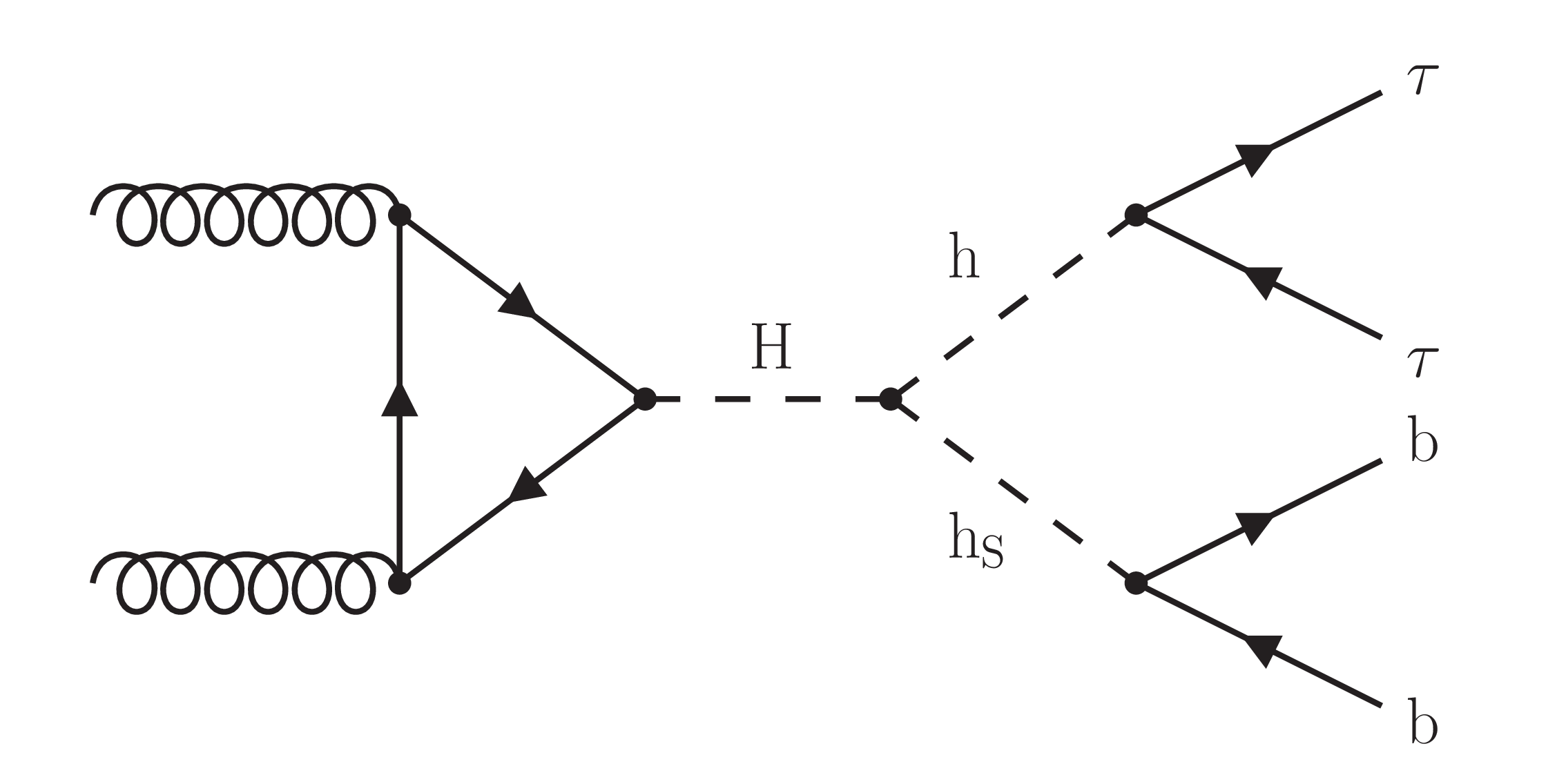
png pdf |
Figure 1:
Feynman diagram of the gg→H→h(ττ)hS(bb) process. |
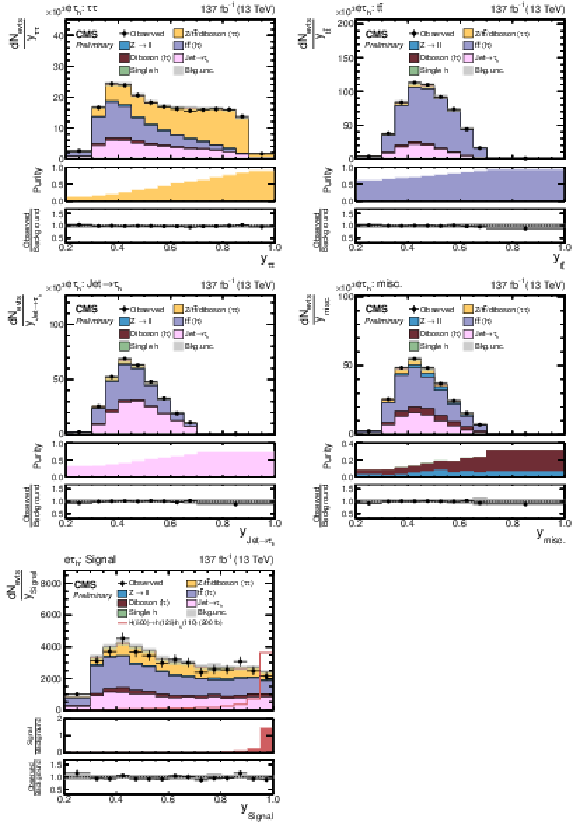
png pdf |
Figure 2:
Event categories after NN classification based on a training for mH= 500 GeV and 100 ≤mhS< 150 GeV in the eτh final state. Shown are the (upper left) ττ, (upper right) tt, (middle left) jet→τh, (middle right) misc, and (lower left) signal categories. For these figures the datasets of all years have been combined. The uncertainty bands correspond to the combination of statistical and systematic uncertainties after the fit to the signal plus background hypothesis for mH= 500 GeV and mhS= 110 GeV. |
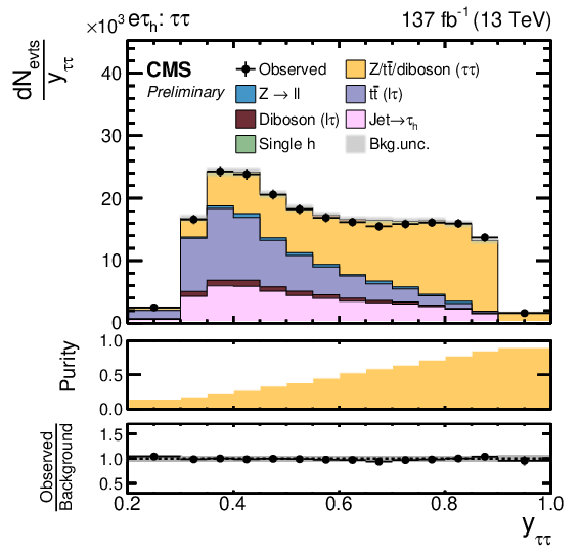
png pdf |
Figure 2-a:
Event categories after NN classification based on a training for mH= 500 GeV and 100 ≤mhS< 150 GeV in the eτh final state. Shown are the (upper left) ττ, (upper right) tt, (middle left) jet→τh, (middle right) misc, and (lower left) signal categories. For these figures the datasets of all years have been combined. The uncertainty bands correspond to the combination of statistical and systematic uncertainties after the fit to the signal plus background hypothesis for mH= 500 GeV and mhS= 110 GeV. |
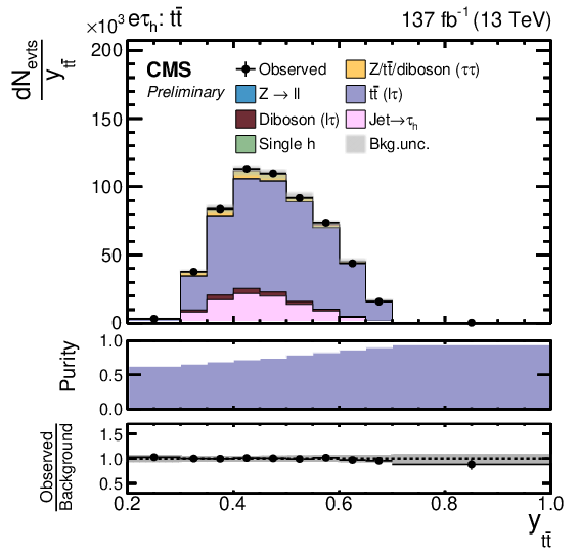
png pdf |
Figure 2-b:
Event categories after NN classification based on a training for mH= 500 GeV and 100 ≤mhS< 150 GeV in the eτh final state. Shown are the (upper left) ττ, (upper right) tt, (middle left) jet→τh, (middle right) misc, and (lower left) signal categories. For these figures the datasets of all years have been combined. The uncertainty bands correspond to the combination of statistical and systematic uncertainties after the fit to the signal plus background hypothesis for mH= 500 GeV and mhS= 110 GeV. |
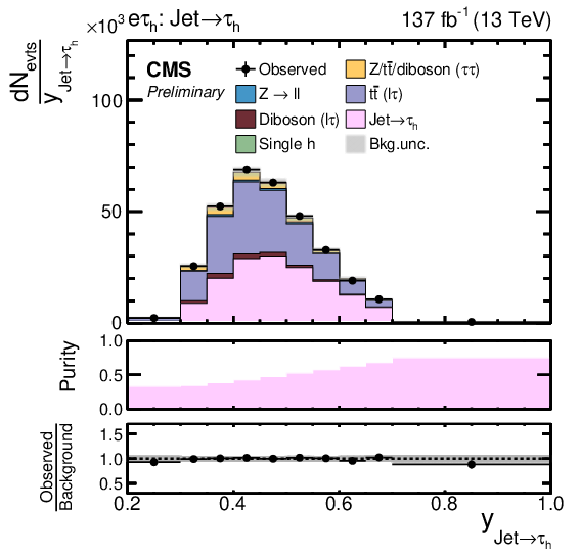
png pdf |
Figure 2-c:
Event categories after NN classification based on a training for mH= 500 GeV and 100 ≤mhS< 150 GeV in the eτh final state. Shown are the (upper left) ττ, (upper right) tt, (middle left) jet→τh, (middle right) misc, and (lower left) signal categories. For these figures the datasets of all years have been combined. The uncertainty bands correspond to the combination of statistical and systematic uncertainties after the fit to the signal plus background hypothesis for mH= 500 GeV and mhS= 110 GeV. |

png pdf |
Figure 2-d:
Event categories after NN classification based on a training for mH= 500 GeV and 100 ≤mhS< 150 GeV in the eτh final state. Shown are the (upper left) ττ, (upper right) tt, (middle left) jet→τh, (middle right) misc, and (lower left) signal categories. For these figures the datasets of all years have been combined. The uncertainty bands correspond to the combination of statistical and systematic uncertainties after the fit to the signal plus background hypothesis for mH= 500 GeV and mhS= 110 GeV. |
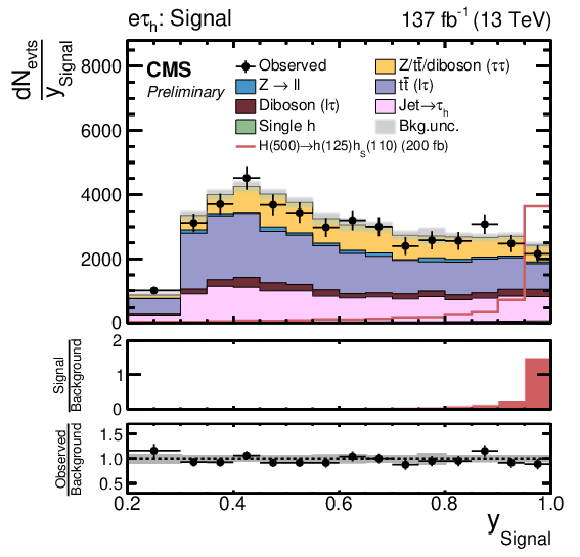
png pdf |
Figure 2-e:
Event categories after NN classification based on a training for mH= 500 GeV and 100 ≤mhS< 150 GeV in the eτh final state. Shown are the (upper left) ττ, (upper right) tt, (middle left) jet→τh, (middle right) misc, and (lower left) signal categories. For these figures the datasets of all years have been combined. The uncertainty bands correspond to the combination of statistical and systematic uncertainties after the fit to the signal plus background hypothesis for mH= 500 GeV and mhS= 110 GeV. |
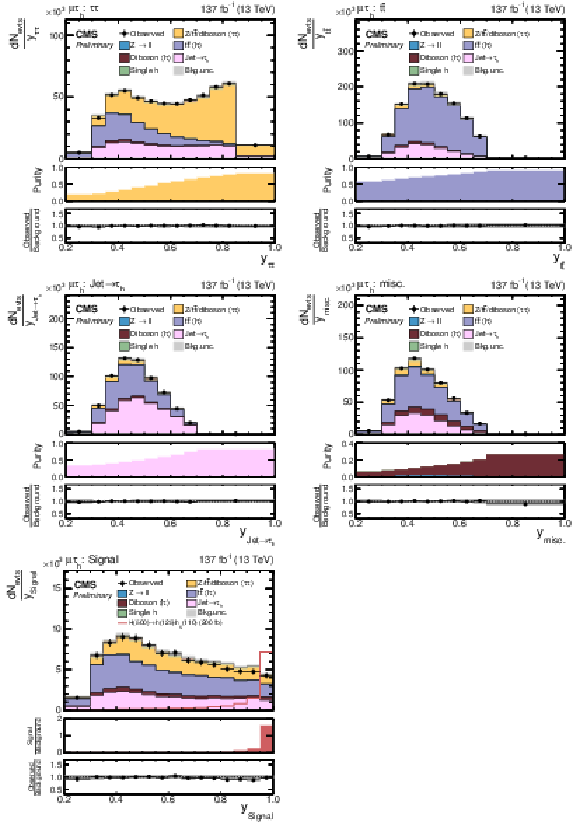
png pdf |
Figure 3:
Event categories after NN classification based on a training for mH= 500 GeV and 100 ≤mhS< 150 GeV in the μτh final state. Shown are the (upper left) ττ, (upper right) tt, (middle left) jet→τh, (middle right) misc, and (lower left) signal categories. For these figures the datasets of all years have been combined. The uncertainty bands correspond to the combination of statistical and systematic uncertainties after the fit to the signal plus background hypothesis for mH= 500 GeV and mhS= 110 GeV. |

png pdf |
Figure 3-a:
Event categories after NN classification based on a training for mH= 500 GeV and 100 ≤mhS< 150 GeV in the μτh final state. Shown are the (upper left) ττ, (upper right) tt, (middle left) jet→τh, (middle right) misc, and (lower left) signal categories. For these figures the datasets of all years have been combined. The uncertainty bands correspond to the combination of statistical and systematic uncertainties after the fit to the signal plus background hypothesis for mH= 500 GeV and mhS= 110 GeV. |

png pdf |
Figure 3-b:
Event categories after NN classification based on a training for mH= 500 GeV and 100 ≤mhS< 150 GeV in the μτh final state. Shown are the (upper left) ττ, (upper right) tt, (middle left) jet→τh, (middle right) misc, and (lower left) signal categories. For these figures the datasets of all years have been combined. The uncertainty bands correspond to the combination of statistical and systematic uncertainties after the fit to the signal plus background hypothesis for mH= 500 GeV and mhS= 110 GeV. |
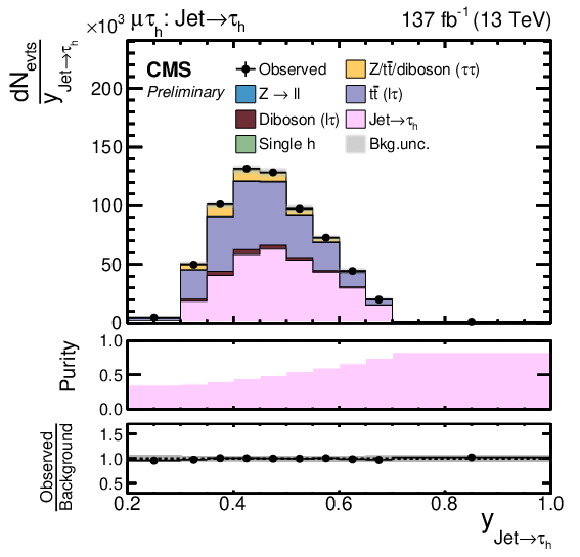
png pdf |
Figure 3-c:
Event categories after NN classification based on a training for mH= 500 GeV and 100 ≤mhS< 150 GeV in the μτh final state. Shown are the (upper left) ττ, (upper right) tt, (middle left) jet→τh, (middle right) misc, and (lower left) signal categories. For these figures the datasets of all years have been combined. The uncertainty bands correspond to the combination of statistical and systematic uncertainties after the fit to the signal plus background hypothesis for mH= 500 GeV and mhS= 110 GeV. |

png pdf |
Figure 3-d:
Event categories after NN classification based on a training for mH= 500 GeV and 100 ≤mhS< 150 GeV in the μτh final state. Shown are the (upper left) ττ, (upper right) tt, (middle left) jet→τh, (middle right) misc, and (lower left) signal categories. For these figures the datasets of all years have been combined. The uncertainty bands correspond to the combination of statistical and systematic uncertainties after the fit to the signal plus background hypothesis for mH= 500 GeV and mhS= 110 GeV. |

png pdf |
Figure 3-e:
Event categories after NN classification based on a training for mH= 500 GeV and 100 ≤mhS< 150 GeV in the μτh final state. Shown are the (upper left) ττ, (upper right) tt, (middle left) jet→τh, (middle right) misc, and (lower left) signal categories. For these figures the datasets of all years have been combined. The uncertainty bands correspond to the combination of statistical and systematic uncertainties after the fit to the signal plus background hypothesis for mH= 500 GeV and mhS= 110 GeV. |
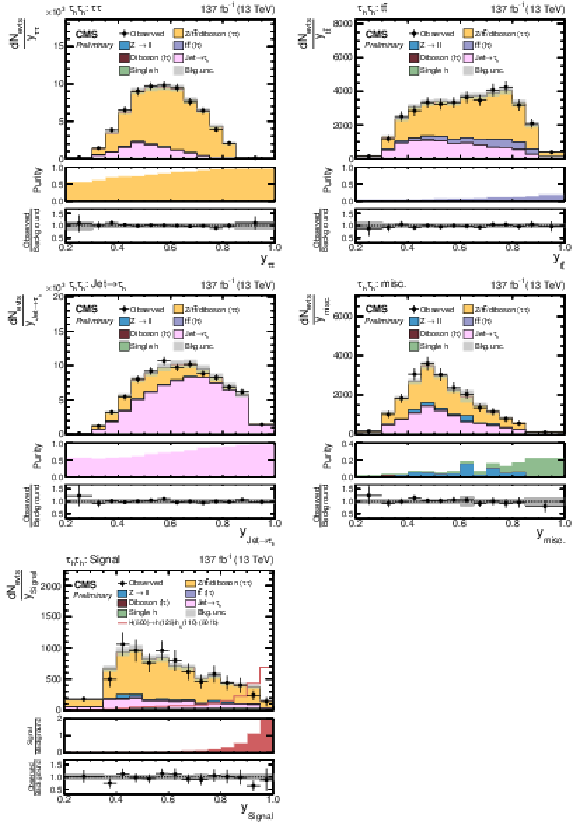
png pdf |
Figure 4:
Event categories after NN classification based on a training for mH= 500 GeV and 100 ≤mhS< 150 GeV in the τhτh final state. Shown are the (upper left) ττ, (upper right) tt, (middle left) jet→τh, (middle right) misc, and (lower left) signal categories. For these figures the datasets of all years have been combined. The uncertainty bands correspond to the combination of statistical and systematic uncertainties after the fit to the signal plus background hypothesis for mH= 500 GeV and mhS= 110 GeV. |

png pdf |
Figure 4-a:
Event categories after NN classification based on a training for mH= 500 GeV and 100 ≤mhS< 150 GeV in the τhτh final state. Shown are the (upper left) ττ, (upper right) tt, (middle left) jet→τh, (middle right) misc, and (lower left) signal categories. For these figures the datasets of all years have been combined. The uncertainty bands correspond to the combination of statistical and systematic uncertainties after the fit to the signal plus background hypothesis for mH= 500 GeV and mhS= 110 GeV. |

png pdf |
Figure 4-b:
Event categories after NN classification based on a training for mH= 500 GeV and 100 ≤mhS< 150 GeV in the τhτh final state. Shown are the (upper left) ττ, (upper right) tt, (middle left) jet→τh, (middle right) misc, and (lower left) signal categories. For these figures the datasets of all years have been combined. The uncertainty bands correspond to the combination of statistical and systematic uncertainties after the fit to the signal plus background hypothesis for mH= 500 GeV and mhS= 110 GeV. |

png pdf |
Figure 4-c:
Event categories after NN classification based on a training for mH= 500 GeV and 100 ≤mhS< 150 GeV in the τhτh final state. Shown are the (upper left) ττ, (upper right) tt, (middle left) jet→τh, (middle right) misc, and (lower left) signal categories. For these figures the datasets of all years have been combined. The uncertainty bands correspond to the combination of statistical and systematic uncertainties after the fit to the signal plus background hypothesis for mH= 500 GeV and mhS= 110 GeV. |

png pdf |
Figure 4-d:
Event categories after NN classification based on a training for mH= 500 GeV and 100 ≤mhS< 150 GeV in the τhτh final state. Shown are the (upper left) ττ, (upper right) tt, (middle left) jet→τh, (middle right) misc, and (lower left) signal categories. For these figures the datasets of all years have been combined. The uncertainty bands correspond to the combination of statistical and systematic uncertainties after the fit to the signal plus background hypothesis for mH= 500 GeV and mhS= 110 GeV. |

png pdf |
Figure 4-e:
Event categories after NN classification based on a training for mH= 500 GeV and 100 ≤mhS< 150 GeV in the τhτh final state. Shown are the (upper left) ττ, (upper right) tt, (middle left) jet→τh, (middle right) misc, and (lower left) signal categories. For these figures the datasets of all years have been combined. The uncertainty bands correspond to the combination of statistical and systematic uncertainties after the fit to the signal plus background hypothesis for mH= 500 GeV and mhS= 110 GeV. |
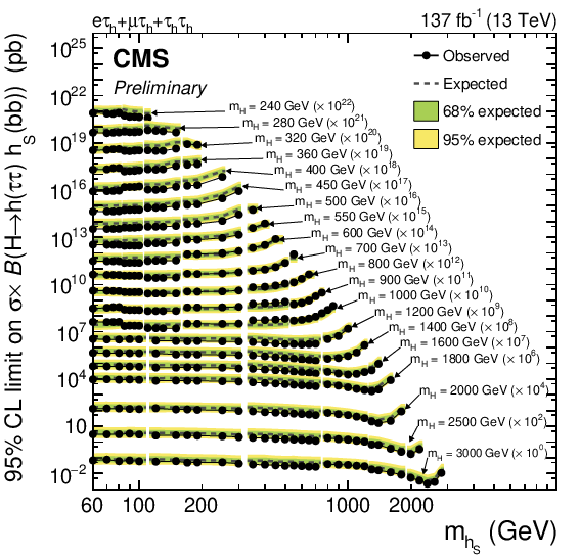
png pdf |
Figure 5:
Expected and observed 95% CL upper limits on σ×B(H→h(ττ)hS(bb)) for all tested mH values. The limits for each corresponding mass value have been scaled by orders of ten as indicated in the annotations. |
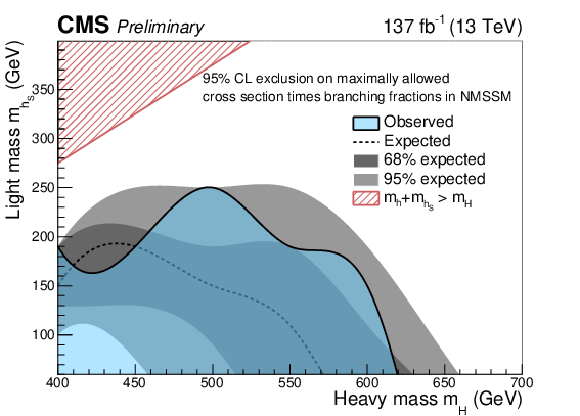
png pdf |
Figure 6:
Mass range in mH and mhS for which the maximally allowed σ×B(H→h(ττ)hS(bb)) within the NMSSM can be excluded at 95% CL by this search. |
| Tables | |
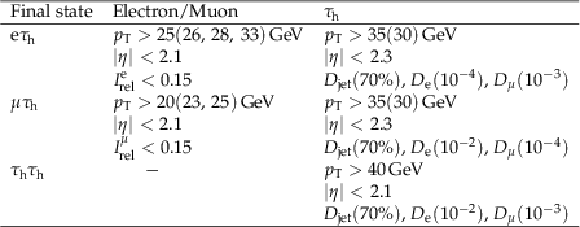
png pdf |
Table 1:
Offline selection requirements applied to electrons, muons, and τh candidates used for the selection of the τ pair. The pT values in braces correspond to the selection criteria for events selected by a single electron or single muon trigger. These requirements depend on the year of data taking. For Djet the efficiency and for De(μ) the rejection rates for the chosen working points are given in braces. A detailed discussion is given in the text. |
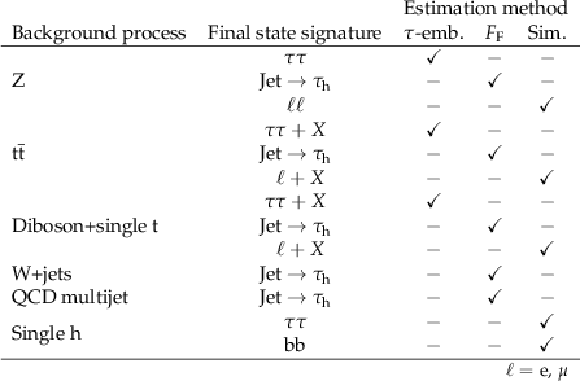
png pdf |
Table 2:
Background processes contributing to the event selection, as given in Section 4. The symbol ℓ corresponds to an electron or muon. The second column refers to the experimental signature in the analysis, the last three columns indicate the estimation methods used to model each corresponding signature as described in Sections 5.1 - 5.3. |
| Summary |
| A search for the decay of a heavy Higgs boson H into the observed Higgs boson h and another Higgs boson hS with a mass of mhS<mH−mh has been presented. The h and the hS bosons are required to decay into a pair of tau leptons and a pair of b quarks, respectively. The search is based on 137 fb−1 of proton-proton collisions collected with the CMS detector during the LHC Run 2 data taking period at a center-of-mass energy of 13 TeV. A mass range of 240 - 3000 GeV for mH and 60 - 2800 GeV for mhS is covered. No signal has been observed. Therefore model independent 95% confidence level upper limits on the product of the production cross section and the branching fractions of the searched process are set ranging from 125 fb (for mH= 240 GeV) to 2.7 fb (for mH= 3000 GeV). These limits have been compared to predictions of the next-to-minimal supersymmetric extension of the standard model. |
| References | ||||
| 1 | ATLAS Collaboration | Observation of a new particle in the search for the standard model Higgs boson with the ATLAS detector at the LHC | PLB 716 (2012) 1 | 1207.7214 |
| 2 | CMS Collaboration | Observation of a new boson at a mass of 125 GeV with the CMS experiment at the LHC | PLB 716 (2012) 30 | CMS-HIG-12-028 1207.7235 |
| 3 | CMS Collaboration | Observation of a new boson with mass near 125 GeV in pp collisions at √s= 7 and 8 TeV | JHEP 06 (2013) 081 | CMS-HIG-12-036 1303.4571 |
| 4 | ATLAS and CMS Collaborations | Measurements of the Higgs boson production and decay rates and constraints on its couplings from a combined ATLAS and CMS analysis of the LHC pp collision data at √s= 7 and 8 TeV | JHEP 08 (2016) 045 | 1606.02266 |
| 5 | CMS Collaboration | Combined measurements of Higgs boson couplings in proton-proton collisions at √s= 13 TeV | EPJC 79 (2019), no. 5, 421 | CMS-HIG-17-031 1809.10733 |
| 6 | ATLAS Collaboration | Combined measurements of Higgs boson production and decay using up to 80 fb−1 of proton-proton collision data at √s= 13 TeV collected with the ATLAS experiment | PRD 101 (2020), no. 1, 012002 | 1909.02845 |
| 7 | CMS Collaboration | Measurements of the Higgs boson width and anomalous HVV couplings from on-shell and off-shell production in the four-lepton final state | PRD 99 (2019), no. 11, 112003 | CMS-HIG-18-002 1901.00174 |
| 8 | \relax Yu. A. Golfand and E. P. Likhtman | Extension of the algebra of Poincaré group generators and violation of p invariance | JEPTL 13 (1971)323 | |
| 9 | J. Wess and B. Zumino | Supergauge transformations in four-dimensions | NPB 70 (1974) 39 | |
| 10 | P. W. Higgs | Broken symmetries, massless particles and gauge fields | PL12 (1964) 132 | |
| 11 | P. W. Higgs | Broken symmetries and the masses of gauge bosons | PRL 13 (1964) 508 | |
| 12 | G. S. Guralnik, C. R. Hagen, and T. W. B. Kibble | Global conservation laws and massless particles | PRL 13 (1964) 585 | |
| 13 | F. Englert and R. Brout | Broken symmetry and the mass of gauge vector mesons | PRL 13 (1964) 321 | |
| 14 | P. W. Higgs | Spontaneous symmetry breakdown without massless bosons | PR145 (1966) 1156 | |
| 15 | T. W. B. Kibble | Symmetry breaking in non-abelian gauge theories | PR155 (1967) 1554 | |
| 16 | P. Fayet | Supergauge invariant extension of the Higgs mechanism and a model for the electron and its neutrino | NPB 90 (1975) 104 | |
| 17 | P. Fayet | Spontaneously broken supersymmetric theories of weak, electromagnetic and strong interactions | PLB 69 (1977) 489 | |
| 18 | J. E. Kim and H. P. Nilles | The mu problem and the strong CP problem | PLB 138 (1984) 150 | |
| 19 | U. Ellwanger, C. Hugonie, and A. M. Teixeira | The next-to-minimal supersymmetric standard model | PR 496 (2010) 1 | 0910.1785 |
| 20 | M. Maniatis | The next-to-minimal supersymmetric extension of the standard model reviewed | Int. J. Mod. Phys. A 25 (2010) 3505 | 0906.0777 |
| 21 | ATLAS Collaboration | Search for heavy Higgs bosons decaying into two tau leptons with the ATLAS detector using pp collisions at √s= 13 TeV | PRL 125 (2020), no. 5, 051801 | 2002.12223 |
| 22 | CMS Collaboration | Search for additional neutral MSSM Higgs bosons in the ττ final state in proton-proton collisions at √s= 13 TeV | JHEP 09 (2018) 007 | CMS-HIG-17-020 1803.06553 |
| 23 | ATLAS Collaboration | Search for charged Higgs bosons decaying via H±→τ±ντ in the τ+jets and τ+lepton final states with 36 fb−1 of pp collision data recorded at √s= 13 TeV with the ATLAS experiment | JHEP 09 (2018) 139 | 1807.07915 |
| 24 | CMS Collaboration | Search for charged Higgs bosons in the H±→τ±ντ decay channel in proton-proton collisions at √s= 13 TeV | JHEP 07 (2019) 142 | CMS-HIG-18-014 1903.04560 |
| 25 | S. King, M. Muehlleitner, R. Nevzorov, and K. Walz | Discovery prospects for NMSSM Higgs bosons at the high-energy large hadron collider | PRD 90 (2014), no. 9, 095014 | 1408.1120 |
| 26 | CMS Collaboration | Description and performance of track and primary-vertex reconstruction with the CMS tracker | JINST 9 (2014), no. 10, P10009 | CMS-TRK-11-001 1405.6569 |
| 27 | CMS Collaboration | Track impact parameter resolution for the full pseudorapidity coverage in the 2017 dataset with the CMS Phase-1 pixel detector | CDS | |
| 28 | CMS Collaboration | Performance of electron reconstruction and selection with the CMS detector in proton-proton collisions at √s= 8 TeV | JINST 10 (2015) P06005 | CMS-EGM-13-001 1502.02701 |
| 29 | CMS Collaboration | Performance of CMS muon reconstruction in pp collision events at √s= 7 TeV | JINST 7 (2012) P10002 | CMS-MUO-10-004 1206.4071 |
| 30 | CMS Collaboration | Performance of photon reconstruction and identification with the CMS detector in proton-proton collisions at √s= 8 TeV | JINST 10 (2015), no. 08, P08010 | CMS-EGM-14-001 1502.02702 |
| 31 | CMS Collaboration | Jet energy scale and resolution in the CMS experiment in pp collisions at 8 TeV | JINST 12 (2017) P02014 | CMS-JME-13-004 1607.03663 |
| 32 | CMS Collaboration | Performance of the CMS Level-1 trigger in proton-proton collisions at √s= 13 TeV | JINST 15 (2020) P10017 | CMS-TRG-17-001 2006.10165 |
| 33 | CMS Collaboration | The CMS trigger system | JINST 12 (2017) P01020 | CMS-TRG-12-001 1609.02366 |
| 34 | CMS Collaboration | The CMS experiment at the CERN LHC | JINST 3 (2008) S08004 | CMS-00-001 |
| 35 | CMS Collaboration | Particle-flow reconstruction and global event description with the CMS detector | JINST 12 (2017), no. 10, P10003 | CMS-PRF-14-001 1706.04965 |
| 36 | M. Cacciari, G. P. Salam, and G. Soyez | FastJet user manual | EPJC 72 (2012) 1896 | 1111.6097 |
| 37 | CMS Collaboration | Electron and photon reconstruction and identification with the CMS experiment at the CERN LHC | CMS-EGM-17-001 2012.06888 |
|
| 38 | CMS Collaboration | Performance of the CMS muon detector and muon reconstruction with proton-proton collisions at √s= 13 TeV | JINST 13 (2018), no. 06, P06015 | CMS-MUO-16-001 1804.04528 |
| 39 | CMS Collaboration | Identification of heavy-flavour jets with the CMS detector in pp collisions at 13 TeV | JINST 13 (2018), no. 05, P05011 | CMS-BTV-16-002 1712.07158 |
| 40 | E. Bols et al. | Jet Flavour Classification Using DeepJet | Submitted to: JINST (2020) | 2008.10519 |
| 41 | CMS Collaboration | Performance of the DeepJet b tagging algorithm using 41.9/fb of data from proton-proton collisions at 13 TeV with Phase 1 CMS detector | CDS | |
| 42 | CMS Collaboration | Performance of reconstruction and identification of τ leptons decaying to hadrons and ντ in pp collisions at √s= 13 TeV | JINST 13 (2018), no. 10, P10005 | CMS-TAU-16-003 1809.02816 |
| 43 | CMS Collaboration | Performance of the DeepTau algorithm for the discrimination of taus against jets, electron, and muons | CDS | |
| 44 | D. Bertolini, P. Harris, M. Low, and N. Tran | Pileup per particle identification | JHEP 10 (2014) 059 | 1407.6013 |
| 45 | CMS Collaboration | Performance of missing transverse momentum reconstruction in proton-proton collisions at √s= 13 TeV using the CMS detector | JINST 14 (2019) P07004 | CMS-JME-17-001 1903.06078 |
| 46 | CMS Collaboration | Evidence for the Higgs boson decay to a bottom quark-antiquark pair | PLB 780 (2018) 501 | CMS-HIG-16-044 1709.07497 |
| 47 | L. Bianchini, J. Conway, E. K. Friis, and C. Veelken | Reconstruction of the Higgs mass in H→ττ events by dynamical likelihood techniques | J. Phys. Conf. Ser. 513 (2014) 022035 | |
| 48 | CMS Collaboration | Searches for a heavy scalar boson H decaying to a pair of 125 GeV Higgs bosons hh or for a heavy pseudoscalar boson A decaying to Zh, in the final states with h→ττ | PLB 755 (2016) 217 | CMS-HIG-14-034 1510.01181 |
| 49 | S. Wunsch, R. Friese, R. Wolf, and G. Quast | Identifying the relevant dependencies of the neural network response on characteristics of the input space | Comput. Softw. Big Sci. 2 (2018), no. 1, 5 | 1803.08782 |
| 50 | X. Glorot and Y. Bengio | Understanding the difficulty of training deep feedforward neural networks | in Proceedings of the thirteenth international conference on artificial intelligence and statistics, 2010 | |
| 51 | R. Shimizu et al. | Balanced mini-batch training for imbalanced image data classification with neural network | in 2018 First International Conference on Artificial Intelligence for Industries (AI4I), 2018 | |
| 52 | D. P. Kingma and J. Ba | Adam: A method for stochastic optimization | 1412.6980 | |
| 53 | A. N. Tikhonov | Solution of incorrectly formulated problems and the regularization method | Soviet Math. Dokl. 4 (1963) 1035 | |
| 54 | CMS Collaboration | An embedding technique to determine ττ backgrounds in proton-proton collision data | JINST 14 (2019), no. 06, P06032 | CMS-TAU-18-001 1903.01216 |
| 55 | CMS Collaboration | Measurement of the Zγ∗→ττ cross section in pp collisions at √s= 13 TeV and validation of τ lepton analysis techniques | EPJC 78 (2018), no. 9, 708 | CMS-HIG-15-007 1801.03535 |
| 56 | J. Alwall et al. | MadGraph 5: Going beyond | JHEP 06 (2011) 128 | 1106.0522 |
| 57 | J. Alwall et al. | The automated computation of tree-level and next-to-leading order differential cross sections, and their matching to parton shower simulations | JHEP 07 (2014) 079 | 1405.0301 |
| 58 | P. Nason | A new method for combining NLO QCD with shower Monte Carlo algorithms | JHEP 11 (2004) 040 | hep-ph/0409146 |
| 59 | S. Frixione, P. Nason, and C. Oleari | Matching NLO QCD computations with parton shower simulations: the POWHEG method | JHEP 11 (2007) 070 | 0709.2092 |
| 60 | S. Alioli, P. Nason, C. Oleari, and E. Re | NLO Higgs boson production via gluon fusion matched with shower in POWHEG | JHEP 04 (2009) 002 | 0812.0578 |
| 61 | S. Alioli, P. Nason, C. Oleari, and E. Re | A general framework for implementing NLO calculations in shower Monte Carlo programs: the POWHEG BOX | JHEP 06 (2010) 043 | 1002.2581 |
| 62 | S. Alioli et al. | Jet pair production in POWHEG | JHEP 04 (2011) 081 | 1012.3380 |
| 63 | E. Bagnaschi, G. Degrassi, P. Slavich, and A. Vicini | Higgs production via gluon fusion in the POWHEG approach in the SM and in the MSSM | JHEP 02 (2012) 088 | 1111.2854 |
| 64 | K. Melnikov and F. Petriello | Electroweak gauge boson production at hadron colliders through O(α2s) | PRD 74 (2006) 114017 | hep-ph/0609070 |
| 65 | M. Czakon and A. Mitov | Top++: A program for the calculation of the top-pair cross-section at hadron colliders | CPC 185 (2014) 2930 | 1112.5675 |
| 66 | N. Kidonakis | Top quark production | in Proceedings, Helmholtz International Summer School on Physics of Heavy Quarks and Hadrons (HQ 2013): JINR, 2013 | 1311.0283 |
| 67 | J. M. Campbell, R. K. Ellis, and C. Williams | Vector boson pair production at the LHC | JHEP 07 (2011) 018 | 1105.0020 |
| 68 | T. Gehrmann et al. | W+W− production at hadron colliders in next to next to leading order QCD | PRL 113 (2014), no. 21, 212001 | 1408.5243 |
| 69 | NNPDF Collaboration | Parton distributions for the LHC run II | JHEP 04 (2015) 040 | 1410.8849 |
| 70 | NNPDF Collaboration | Parton distributions from high-precision collider data | EPJC 77 (2017), no. 10, 663 | 1706.00428 |
| 71 | CMS Collaboration | Event generator tunes obtained from underlying event and multiparton scattering measurements | EPJC 76 (2016), no. 3, 155 | CMS-GEN-14-001 1512.00815 |
| 72 | CMS Collaboration | Extraction and validation of a new set of CMS PYTHIA8 tunes from underlying-event measurements | EPJC 80 (2020), no. 1, 4 | CMS-GEN-17-001 1903.12179 |
| 73 | T. Sjostrand, S. Mrenna, and P. Z. Skands | A brief introduction to PYTHIA 8.1 | CPC 178 (2008) 852 | 0710.3820 |
| 74 | T. Sjostrand et al. | An introduction to PYTHIA 8.2 | CPC 191 (2015) 159 | 1410.3012 |
| 75 | S. Agostinelli et al. | GEANT4--a simulation toolkit | NIMA 506 (2003) 250 | |
| 76 | CMS Collaboration | Measurements of inclusive W and Z cross sections in pp collisions at √s= 7 TeV | JHEP 01 (2011) 080 | CMS-EWK-10-002 1012.2466 |
| 77 | CMS Collaboration | Measurement of the differential cross section for top quark pair production in pp collisions at √s= 8 TeV | EPJC 75 (2015), no. 11, 542 | CMS-TOP-12-028 1505.04480 |
| 78 | S. Baker and R. D. Cousins | Clarification of the use of chi square and likelihood functions in fits to histograms | NIM221 (1984) 437 | |
| 79 | R. J. Barlow and C. Beeston | Fitting using finite Monte Carlo samples | CPC 77 (1993) 219 | |
| 80 | CMS Collaboration | CMS luminosity measurements for the 2016 data taking period | CMS-PAS-LUM-17-001 | CMS-PAS-LUM-17-001 |
| 81 | CMS Collaboration | CMS luminosity measurement for the 2017 data-taking period at √s= 13 TeV | CMS-PAS-LUM-17-004 | CMS-PAS-LUM-17-004 |
| 82 | CMS Collaboration | CMS luminosity measurement for the 2018 data-taking period at √s= 13 TeV | CMS-PAS-LUM-18-002 | CMS-PAS-LUM-18-002 |
| 83 | T. Junk | Confidence level computation for combining searches with small statistics | NIMA 434 (1999) 435 | hep-ex/9902006 |
| 84 | A. L. Read | Presentation of search results: The CLs technique | JPG 28 (2002) 2693 | |
| 85 | ATLAS and CMS Collaborations | Procedure for the LHC Higgs boson search combination in summer 2011 | ATL-PHYS-PUB 2011-11, CMS NOTE 2011/005, CERN | |
| 86 | CMS Collaboration | Combined results of searches for the standard model Higgs boson in pp collisions at √s= 7 TeV | PLB 710 (2012) 26 | CMS-HIG-11-032 1202.1488 |
| 87 | G. Cowan, K. Cranmer, E. Gross, and O. Vitells | Asymptotic formulae for likelihood-based tests of new physics | EPJC 71 (2011) 1554 | 1007.1727 |
| 88 | U. Ellwanger and C. Hugonie | NMHDECAY 2.0: An updated program for sparticle masses, Higgs masses, couplings and decay widths in the NMSSM | CPC 175 (2006) 290 | hep-ph/0508022 |
| 89 | J. Baglio et al. | NMSSMCALC: A program package for the calculation of loop-corrected Higgs boson masses and decay widths in the (complex) NMSSM | CPC 185 (2014), no. 12 | 1312.4788 |

|
Compact Muon Solenoid LHC, CERN |

|

|

|

|

|

|